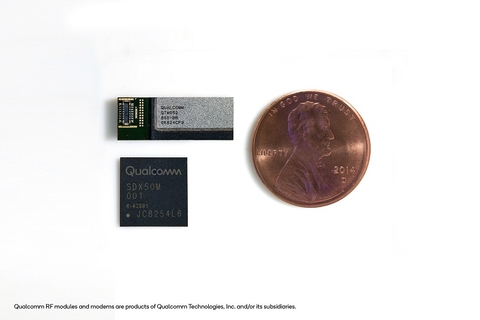Qualcomm engineers promised they would deliver the ability to pack 5G into a smartphone form factor, and deliver is what they’re doing today with the unveiling of the world’s first fully integrated 5G NR millimeter wave and sub-6 GHz RF modules for smartphones and other mobile devices.
The Qualcomm QTM052 mmWave antenna module family and the Qualcomm QPM56xx sub-6 GHz RF module family pair with the Qualcomm Snapdragon X50 5G modem to deliver modem-to-antenna capabilities across several spectrum bands.
“Today’s announcement of the first commercial 5G NR mmWave antenna modules and sub-6 GHz RF modules for smartphones and other mobile devices represents a major milestone for the mobile industry,” said Qualcomm President Cristiano Amon in a prepared statement. “Qualcomm Technologies’ early investment in 5G has allowed us to deliver to the industry a working mobile mmWave solution that was previously thought unattainable, as well as a fully-integrated sub-6 GHz RF solution.”
The news is notable for several reasons, including, as Amon pointed out, because many longtime industry experts were skeptical that millimeter wave would be acceptable for mobile applications and that the technology would fit into a form factor as small as a smartphone. Qualcomm’s engineers spent years working on ways to make it happen.
Millimeter wave signals don’t travel far and they’re easily blocked, behaving erratically and scatterring off surfaces. But there are techniques engineers can use to make the disadvantages work to their advantage, such as beamforming and beam steering.
“It’s important that we got to this milestone now in this time frame because we really are at the precipice” of the 5G network launches, Sherif Hanna, director of 5G product marketing at Qualcomm, told FierceWirelessTech.
RELATED: Qualcomm unveils 5G NR solution for small cells
All of the biggest U.S. service providers are talking about 5G network launches. Last week, AT&T added a few more markets to its roster of markets to go live by the end of this year, most likely with a pucklike device as opposed to a handset. Hanna said devices for mobile hotspots or mobile data cards are likely to launch in 2018, but he does not see 5G smartphones arriving until 2019 despite a great deal of pressure to make it happen this year.

and Qualcomm Snapdragon X50 (Qualcomm)
Qualcomm’s engineers managed to make the modules small enough to fit into the bezel of a phone, and OEMs can fit four of them in a handset. That way, if a customer's hand covers up one module or if the consumer is walking down a busy street and a delivery truck happens to block the signal, the phone will be able to switch to another module to keep the connection going.
Qualcomm's products support up to 800 MHz of bandwidth in the 26.5-29.5 GHz band, as well as the entire 27.5-28.35 GHz and 37-40 GHz bands. OEMs will be able to incorporate whichever bands fit their needs for a given geography; for example, in the U.S., they may want to include support for both 28 and 39 GHz.
It’s worth noting that voice services are not being talked about for 5G; the voice component will still be delivered via LTE. Qualcomm said both the QTM052 mmWave antenna module family and the QPM56xx sub-6 GHz RF module family are now sampling to customers.

